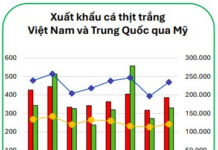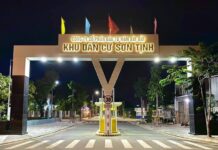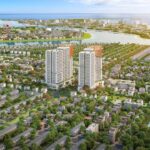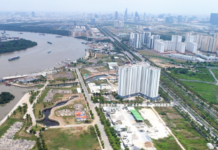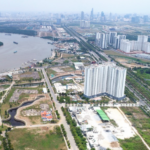Megacities are meticulously planned from the outset, boasting robust transportation networks and ample space for parks, schools, hospitals, and shopping centers. This holistic approach creates a complete and upscale living environment, a feat that traditional cities often struggle to achieve. Consequently, this trend is poised to attract significant interest in the future.
Relieving Pressure on Central Urban Areas
Discussing the role of megacities, which are being developed by major corporations, Mr. Lê Hoàng Châu, Chairman of the Ho Chi Minh City Real Estate Association (HOREA), asserts that the emergence of large-scale projects spanning thousands, or even tens of thousands, of hectares is a growing trend in urban development. This is particularly evident in developing countries, especially across Asia.
With the rapid urbanization and population concentration in cities, the development of large-scale megacity projects is a crucial solution to alleviate the strain on overburdened central urban areas, particularly in terms of infrastructure.
“Therefore, megacity projects play a pivotal role in decentralizing populations from city centers, redistributing both people and resources. Moreover, their substantial scale offers advantages in construction, enabling the establishment of synchronized, modern infrastructure and comprehensive amenities, including the pursuit of smart city initiatives,”
Mr. Châu explains.
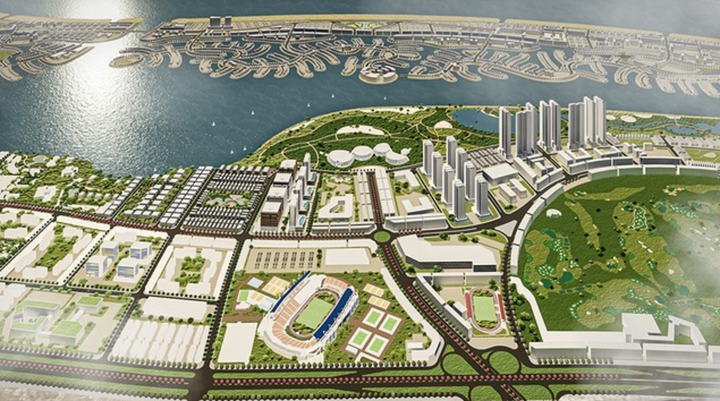
Megacities contribute to resolving the housing supply bottleneck. (Illustrative image)
Echoing this perspective, Dr. Nguyễn Văn Đính, Vice Chairman of the Vietnam Real Estate Association (VNREA), predicts that the megacity model will propel Vietnam into a leading position in Southeast Asia and among the world’s top 20 economies within the next 10 to 20 years.
According to Dr. Đính, the model of megacities spanning hundreds or thousands of hectares has become increasingly prevalent in recent times across various localities, establishing itself as a clear trend.
“Previously, we only had urban areas like Phú Mỹ Hưng, which could be considered large. However, in recent years, megacities have been emerging more frequently, with the most notable example being Vinhomes Green Paradise in Cần Giờ, covering 2,870 hectares. This trend primarily stems from the growing demand for higher living standards among residents. People aspire to live in places with comprehensive amenities and assured security, and the megacity model effectively meets these legitimate expectations,”
Dr. Đính remarks.
Dr. Đính further elaborates: When viewed within the current socio-economic landscape and overall context, the formation of megacities is inevitable, contributing to attracting both domestic and foreign investors.
“International examples, such as Tokyo and Seoul, have demonstrated that development following this model becomes a significant growth driver for nations. These areas can account for up to 50% of the population and over 55% of the country’s GDP. Similarly, Singapore has developed according to a five-wing model, with each ‘wing’ representing a distinct megacity ensuring a high quality of life,”
Dr. Đính illustrates.
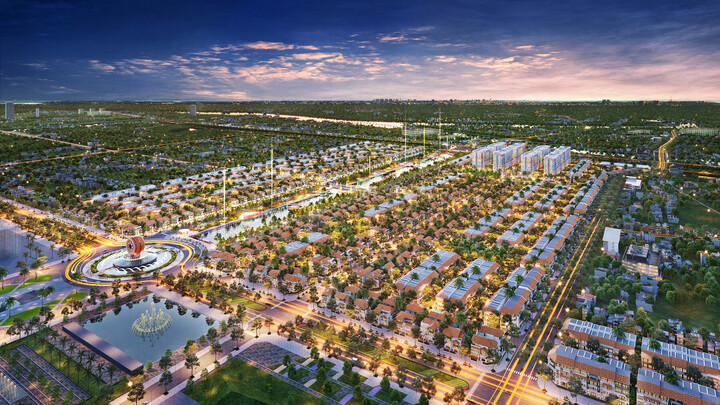
A megacity under construction in Hanoi. (Illustrative image)
Dr. Đính also emphasizes that the emergence of a megacity typically generates a substantial and long-term supply. With tens of thousands of units introduced according to a planned schedule, the real estate market will become more stable, ensuring diverse supply and curbing unreasonable price increases.
“More importantly, megacities introduce an entirely new living space where people can live, work, and entertain within the same area without the need for extensive travel. This is the model of the future. If we continue to develop as we have, focusing on expanding roads in congested areas, cities will remain constrained by outdated infrastructure. Therefore, megacities are the sole solution to alleviate central pressure and create a more humane and livable environment,”
Dr. Đính asserts.
Attracting Investment from Major Corporations
Experts also agree that, with their numerous advantages, megacities will become a preferred investment for financially robust major developers. Consequently, megacities are becoming increasingly prevalent.
Vietnam’s first model urban area, Phú Mỹ Hưng, was constructed 30 years ago with an area exceeding 400 hectares. Its construction density is only 25%, with the remainder dedicated to roads, greenery, water bodies, and public facilities.
Similarly, Ecopark in Hưng Yên, developed 20 years ago, has transformed former agricultural land into an urban area featuring extensive greenery and water bodies.
Recently, megacities like Vinhomes Green Paradise in Cần Giờ (Ho Chi Minh City) and Sun Mega City in Ninh Bình have also garnered significant public attention.
“Developers and corporations undertaking megacity projects must possess genuine capabilities in finance, planning, design, and project management. Beyond attracting domestic investment, the megacity model also presents opportunities to draw foreign capital into Vietnam. Therefore, the trend of building megacities is highly necessary and should be pursued,”
Mr. Châu states.
Concurring, Dr. Nguyễn Văn Đính notes that megacities serve as catalysts for investment, particularly high-quality FDI. With synchronized planning of transportation, services, and technology infrastructure from the outset, megacities become attractive destinations for large domestic enterprises and international companies in sectors such as manufacturing, trade, retail, healthcare, and education.
“
Enterprises are constantly seeking new ‘growth poles’ with large land areas, excellent infrastructure, and a civilized living environment. Megacities meet these criteria and can drive a very strong investment value chain, helping localities increase budget revenue and establish a sustainable economic ecosystem
”, Dr. Nguyễn Văn Đính affirms.
Meanwhile, expert Bùi Văn Doanh, Director of the Vietnam Real Estate Research Institute, emphasizes that for a megacity to succeed, it must meet three core conditions.
First, the area where the city is located must have development momentum, such as advantages in tourism, industrial zones, commerce, services, or specific natural advantages.
Second, it must have an extremely robust transportation infrastructure system with multi-directional connectivity, including highways and metros.
Third, it requires a developer of sufficient caliber. Megacities cannot be fragmented and assigned to multiple developers, as was the case in Ho Chi Minh City in the past. A modern megacity is not merely a ‘residential area’ but must be capable of connecting multiple sectors, from services and commerce to production, developed according to the highest ESG standards. Therefore, this model needs to be led by enterprises with financial capacity, planning experience, and connectivity capabilities.
“If executed well, I believe this will be a turning point in the next 10 to 20 years. When a multi-centered urban model is established, Ho Chi Minh City and Hanoi will no longer be as densely populated as they are now. Satellite megacities will become integrated places for living, working, production, and services, contributing to reducing central pressure and creating new growth momentum,”
Mr. Doanh says.
Mr. Doanh also cautions that allowing the construction of megacities is a historic opportunity but should not be applied uniformly:
“If done correctly, focusing on a few good core areas, megacities will become a lever for Vietnam’s breakthrough, raising living standards, attracting foreign capital, and restructuring the entire national urban development model. This will be the driving force for us to rise to the top in Southeast Asia and enter the world’s top 20 economies.”
Today’s Live Pig Prices, November 22: Surging Across Most Regions
After a prolonged period of price reductions, hog prices across regions have been adjusted upward by livestock companies, with increases reaching up to 4,000 VND per kilogram.
Unlocking New Growth Hubs: Navigating Da Nang’s Investment Landscape
As Da Nang expands its development southward, the Hoa Xuan area has rapidly emerged as a new urban hub. Capitalizing on this trend, Sun Group is crafting Sun NeO City—a strategically located project with synchronized infrastructure and a sustainable vision, poised to become the focal point of southern Da Nang.
Iconic Tower in Ho Chi Minh City Elevates Every Home Within Its View
Landmark 81 stands as not only an architectural icon of Ho Chi Minh City but also a new benchmark for apartments with breathtaking views. Real estate agents reveal that often, clients are so captivated by the sight of Landmark 81 that they instantly decide to purchase a unit with this stunning vista.


















